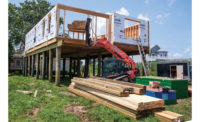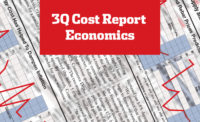While price increases in softwood lumber have pushed new home costs higher due to homebuilders’ extensive use of the material, estimators for all other building types have felt the pinch as well.
Several contractors working on everything from transit systems to high-rise office buildings say that the cost of lumber, particularly for use in concrete framing, is hurting their bottom lines. Contractors also report difficulty in acquiring several products—including softwood lumber, steel, copper, aluminum, insulation, roofing materials and PVC—in adequate quantities, with some suppliers even canceling original sales when other customers can pay more.
“Paying a premium for lumber is obviously not ideal and has added a challenge to several large concrete projects we’re currently managing, but an even greater challenge is the limited availability and the potential schedule risk that represents,” says Josh Lawrence, senior vice president of preconstruction at McCarthy Building Cos. in St. Louis.
Related link: ENR 2021 2Q Cost Report PDF
(Subscription Required)
According to the executive, supply shortages of plywood are requiring McCarthy project teams to find new ways to get materials, including use of multiple vendors and different product types to procure enough wood to keep concrete forming crews productive and projects on schedule.
David Shier, project executive for the Walsh-Fluor joint venture working on the $1.5-billion Chicago Transit Authority Red/Purple modernization project, says that the team is talking to its client about using a different price index than one from the Illinois Dept. of Transportation, which participants say is not as responsive as necessary with the rapid price shifts in materials this year.
Goldman Sachs reports that the worst supplier delivery delays in two decades happened in the last 12 months. The bank expects delivery times to remain longer than normal through the end of the year and, potentially, into 2022. In questions included in Goldman Sachs’ regional business surveys, a majority of manufacturers consistently reported their own supply chain disruptions.
Lawrence says that most commercial building materials remain challenging to estimate and purchase, with materials pricing and lead times doubling over the last year in some cases.
Tariff Turmoil
The Associated General Contractors of America called on the Biden administration to eliminate tariffs placed on steel, aluminum and lumber by the Trump administration.
But in late May, the Commerce Dept. instead recommended doubling the tariff on Canadian softwood lumber.
“These [supply] challenges will make it more costly and difficult to achieve the administration’s goals for infrastructure, renewable energy and affordable housing,” AGC President and CEO Stephen Sandherr said June 8. “The President could provide immediate relief from soaring prices for lumber, steel and aluminum by removing harmful tariffs and quotas. Unfortunately, [his] recommendations ignore that quick and effective approach.”
“These [supply] challenges will make it more costly and difficult to achieve the administration’s goals for infrastructure, renewable energy and affordable housing.”
— AGC President and CEO Stephen Sandherr
The Commerce Dept. preliminary determination recommends raising the tariff on most Canadian softwood lumber producers to 18.3% from the current 9% anti-dumping and countervailing duties that were imposed during the Trump administration. The new rates could go into effect by October if no further action is taken.
“At a time when construction is facing an unprecedented surge in material costs, calling for increases in tariffs and quotas could impose additional costs, further impact the rising price of critical products like softwood lumber, hurt the construction industry overall and fracture relations with our trading partners,” says Peter Comstock, senior director of legislative affairs at the Associated Builders and Contractors of America.
“This short-sighted proposal would have a long-term impact on the American people, and the Biden administration must, instead, commit to enacting policies that address this affordability crisis and increase the supply of crucial products like lumber for the U.S.,” he says.
The Quebec Wood Export Bureau, which represents lumber mills from the province, says that the method used by the Commerce Dept. was flawed because the imports that the department analyzed to come up with its rates occurred in 2019.
“You may base it on the price that was readily available in 2020 or early 2021,” says Sven Gustavsson, board manager of softwood and value-added softwood lumber at the bureau. “In their review, they adjusted it and actually based it on 2019 figures.”
The period investigated in the review document is Jan. 1, 2019 through Dec. 31, 2019, when prices were far lower than today. But the U.S. Lumber Coalition, a group of domestic lumber manufacturers, cheered the findings. It insisted that the tariffs in the long-running dispute, which goes back to the Obama administration, were necessary as many Canadian lumber trees are grown on federal land so that Canadian producers pay only “stumpage fees,” which U.S. producers believe are artificially low and a form of subsidy.
“The U.S. Lumber Coalition applauds the Commerce Dept.’s continued commitment to strongly enforce the U.S. trade laws against subsidized and unfairly traded Canadian lumber imports,” said Jason Brochu, co-chair of the group and co-president of Pleasant River Lumber Co., Foxcroft, Maine, in a statement.
Gustavsson of the Quebec bureau disputes the assertion that eastern Canada’s lumber competes for the same customers with the U.S.
“We don’t have any huge-diameter pines [that U.S. producers have],” he says. “Small diameter spruce is, far and away, our market, basically pulp logs that we are turning into two-by-fours and two-by-sixes, so the value is low for those logs, but that little spruce log is being compared with a big southern yellow pine log.”
U.S. contractors are trying to plan the rest of their purchasing year and see higher tariffs in the fall as yet another hurdle to procurement in a year already full of challenges.
“Most suppliers are predicting that pricing will begin to level off in the summer and continue to drop over the next year,” Lawrence says. “But some have warned that as the price drops, the lead times could become even more of an issue as large orders are placed, and resources get further stretched.”






Post a comment to this article
Report Abusive Comment